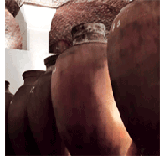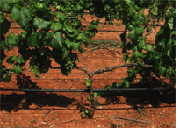Wine production in Alentejo is extremely characteristic and some producers and bottlers still use ancestral winemaking techniques. Examples of such are the use of pitchers (which were used in Roman times) and cement presses.
 Traditional winemaking processes are used by a small percentage of producers and/or bottlers. Therefore, only a few wines available in the market were produced using such processes. Such wines, especially the ones fermented in pitchers, are very characteristic and commercially successful. In Alentejo, this method is also used in the production of wines for household consumption.
Traditional winemaking processes are used by a small percentage of producers and/or bottlers. Therefore, only a few wines available in the market were produced using such processes. Such wines, especially the ones fermented in pitchers, are very characteristic and commercially successful. In Alentejo, this method is also used in the production of wines for household consumption.
 Modern winemaking technologies are used in the production of soft, deeply coloured young wines full of aroma and flavour. White wines, namely monovarietals, undergo skin maceration, i.e., the berries, together with their skins, are placed in tanks at controlled temperatures for 12 to 48 hours, in order to extract all of the skins' qualities.
Modern winemaking technologies are used in the production of soft, deeply coloured young wines full of aroma and flavour. White wines, namely monovarietals, undergo skin maceration, i.e., the berries, together with their skins, are placed in tanks at controlled temperatures for 12 to 48 hours, in order to extract all of the skins' qualities.
Red wines from Alentejo are fermented at lower temperatures than in other wine regions and malolactic fermentation takes place a few months after winemaking.
 Most whites are consumed in the year after harvest; therefore, they don’t undergo ageing. Regional red wines don’t need to age; however, QWPSR usually undergo a small ageing period of 1 or 2 years in stainless steel, cement, wood or glass (bottle) containers.
Most whites are consumed in the year after harvest; therefore, they don’t undergo ageing. Regional red wines don’t need to age; however, QWPSR usually undergo a small ageing period of 1 or 2 years in stainless steel, cement, wood or glass (bottle) containers.
White wines from Alentejo have good acidity, a clear appearance and are citrine coloured. They are intensely scented and extremely smooth. The red wines are robust, deeply coloured and very aromatic. In the mouth, they are velvety and have a long flavour.
 Back to map
Back to map